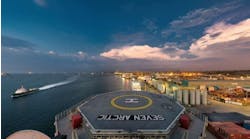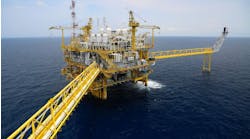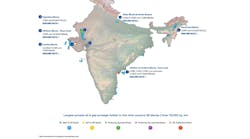Tim JacksonElectric submersible pumps (ESP) have been used for simple conventional artificial lift operations for many years. Over the last five years, a broader range of ESP systems has emerged, many of which have already been applied to improve the viability of the fields concerned. However, some of the best opportunities for ESP technology-based solutions are yet to be exploited.
Centrilift UK
In the past 12 months, an ESP system capable of pumping over 20,000 b/d has been successfully installed by Centrilift for BP's Wytch Farm facility on the English south coast. The setting depth is more than 8.5 km, in an offshore well stretching a full 10 km from the wellhead. This achievement demonstrates the practicality of ESPs in ultra-remote wells, but solutions are also emerging for subsea wells and marginal reserves.
In the mature UK sector, North Sea operators are seeking new ways of developing smaller accumulations and fields which contain problematic or heavy fluids. To this end, Centrilift has introduced coiled tubing ESP deployment, which allows artificial lift systems to be installed in wells without the need for costly workover rigs and with only a single pay-off reel.
Annulus production
The patented system, known as Mark 2 - Electrocoil, features the power cable within the coiled tubing, allowing production through the annulus. The system is suited for installation by monohulled light intervention vessels. It is also more effective than its predecessor, the Mark 1 CT ESP, which relied on clamping of the cable to the outside of the coiled tubing. This system was also slow to run in and out of wells, requiring two separate reels and offering only limited production rates through the coiled tubing.Electrocoil, however, uses steel cable clamps which are held in place with carefully designed dimples to support the cable within the tubing. As an integrated life-of-tubing system, it is easily installed in a well and can be removed quickly for workover purposes.
Since the cable is protected from the downhole environment by the coiled tubing, Electrocoil has the potential to deliver extended run-life. And significantly, it offers potential for installation of ESPs in live wells, thereby avoiding the costs and threats of formation damage associated with kill fluids. The first Electrocoil system is about to be installed in Alaska by ARCO, with a first North Sea application expected later this year.
Gas/water treatment
Since the early 1990's, the capacity of ESPs has virtually doubled. High power pumps such as those deployed by Norsk Hydro on the Brage Field can produce up to 80,000 b/d. Other advances in the technology have led to traditional problems associated with high levels of free gas being overcome. Centrilift's GLR systems can handle over 40% free gas through use of an advanced impeller/diffuser design which produces a homogenous flow. The boosting energy is applied much closer to the actual reservoir than more traditional subsea multiphase pumping methods, leading to efficiency improvements.Norsk Hydro's Brage pumps are also used to produce 25,000 cu meters/day of aquifer water for injection. The advantages over seawater injection include greater flexibility to cope with reservoir uncertainties, reduced topside requirements, and the avoidance of barium sulfide scaling. Finally, virtually all oil wells produce with increasing water-cuts towards the end of their lives. In viscous fields, many wells are afflicted by this problem throughout production. However, ESP technology is now being applied to separate oil and water downhole.
The HydroSep system uses a reconfigured ESP assembly to boost the total produced fluid stream, which is then separated using a Vortoil hydrocyclone system. The result is a high quality water "reject" stream which can then be reinjected safely to provide pressure support to the reservoir. Alternately, the water can be disposed of by injection into another formation. Hydrosep can remove almost all the water from the fluid mix, even when water cuts reach as much as 99%.
Copyright 1998 Oil & Gas Journal. All Rights Reserved.


